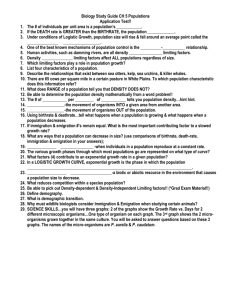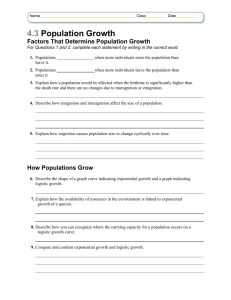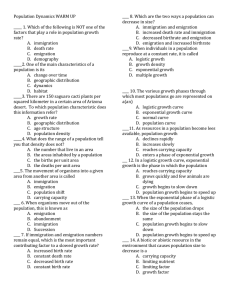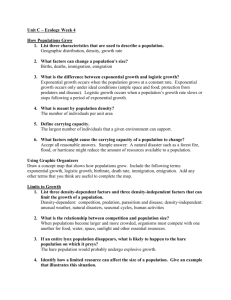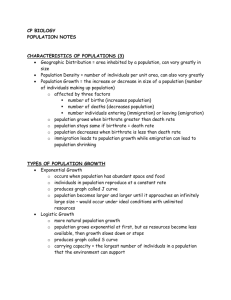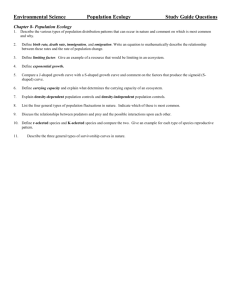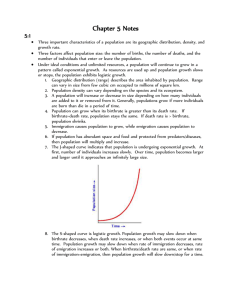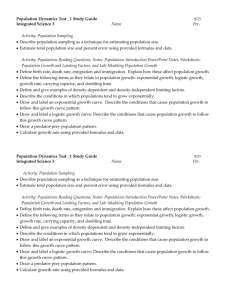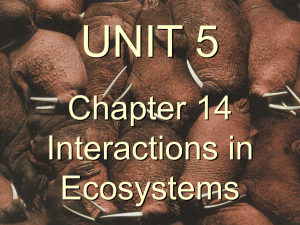Population and Biodiversity in an Ecosystem
advertisement
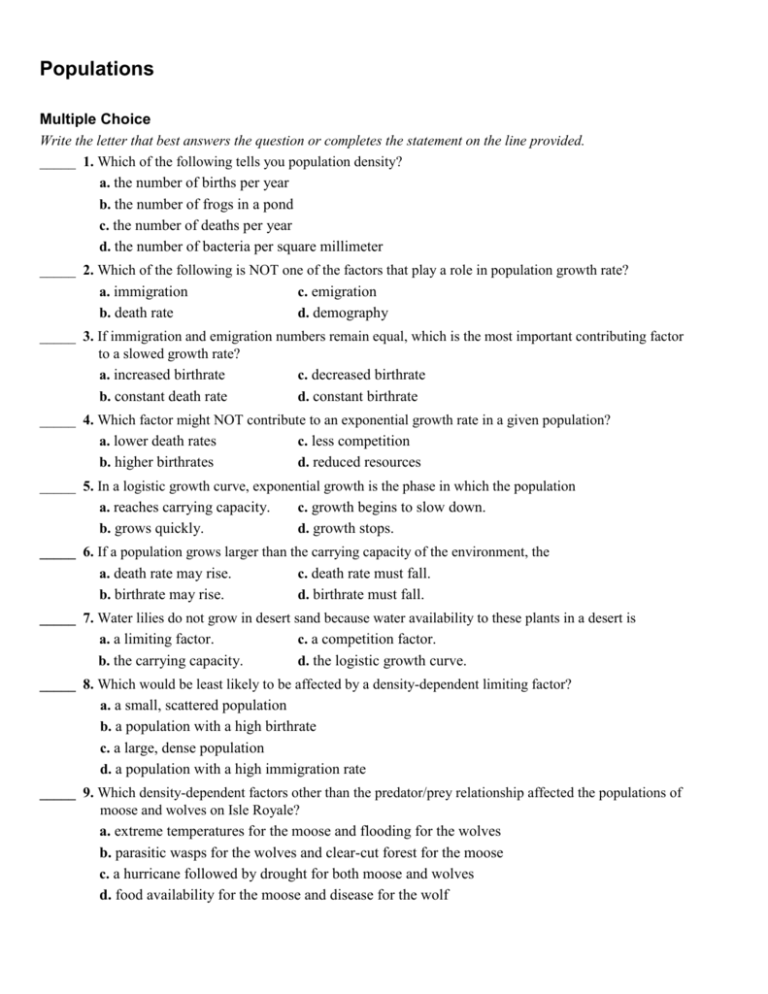
Populations Multiple Choice Write the letter that best answers the question or completes the statement on the line provided. _____ 1. Which of the following tells you population density? a. the number of births per year b. the number of frogs in a pond c. the number of deaths per year d. the number of bacteria per square millimeter _____ 2. Which of the following is NOT one of the factors that play a role in population growth rate? a. immigration c. emigration b. death rate d. demography _____ 3. If immigration and emigration numbers remain equal, which is the most important contributing factor to a slowed growth rate? a. increased birthrate c. decreased birthrate b. constant death rate d. constant birthrate _____ 4. Which factor might NOT contribute to an exponential growth rate in a given population? a. lower death rates c. less competition b. higher birthrates d. reduced resources _____ 5. In a logistic growth curve, exponential growth is the phase in which the population a. reaches carrying capacity. c. growth begins to slow down. b. grows quickly. d. growth stops. _____ 6. If a population grows larger than the carrying capacity of the environment, the a. death rate may rise. c. death rate must fall. b. birthrate may rise. d. birthrate must fall. _____ 7. Water lilies do not grow in desert sand because water availability to these plants in a desert is a. a limiting factor. c. a competition factor. b. the carrying capacity. d. the logistic growth curve. _____ 8. Which would be least likely to be affected by a density-dependent limiting factor? a. a small, scattered population b. a population with a high birthrate c. a large, dense population d. a population with a high immigration rate _____ 9. Which density-dependent factors other than the predator/prey relationship affected the populations of moose and wolves on Isle Royale? a. extreme temperatures for the moose and flooding for the wolves b. parasitic wasps for the wolves and clear-cut forest for the moose c. a hurricane followed by drought for both moose and wolves d. food availability for the moose and disease for the wolf _____ 10. Which of the following is a density-independent limiting factor? a. a struggle for food, water, space, or sunlight b. predator/prey relationships c. the eruption of a volcano d. parasitism and disease Figure 5-1 _____ 11. The graph in Figure 5–1 shows the changes in a mosquito population. What caused the changes seen in the graph? a. a reduction in resources c. a density-independent limiting factor b. an increase in predation d. a density-dependent limiting factor _____ 12. About 500 years ago, the world’s population started a. decreasing. c. growing more rapidly. b. to reach carrying capacity. d. to level off. _____ 13. Countries in the first stage of demographic transition have a. a high death rate and a high birthrate. b. a high death rate and a low birthrate. c. a slowly growing population. d. more old people than young people. _____ 14. The anticipated human population by the year 2050 is about a. 7.8 billion. c. 9 trillion. b. 9 billion. d. 78 billion. _____ 15. In countries like India, the human population is growing a. exponentially. c. logistically. b. transitionally. d. demographically _____ 16. There are 150 Saguaro cactus plants per square kilometer in a certain area of Arizona desert. To which population characteristic does this information refer? a. growth rate c. age structure b. geographic range d. population density _____ 17 What does the range of a population tell you that density does not? a. the number that live in an area b. the areas inhabited by a population c. the births per unit area d. the deaths per unit area _____ 18. The movement of organisms into a range is called a. immigration. c. population shift. b. emigration. d. carrying capacity. _____ 19. Which are two ways a population can decrease in size? a. immigration and emigration b. increased death rate and immigration c. decreased birthrate and emigration d. emigration and increased birthrate Figure 5–1 _____ 20. The graph in Figure 5–1 shows the growth of a bacterial population. Which of the following correctly describes the growth curve? a. logistic c. demographic b. limiting d. exponential _____ 21. During some kinds of population growth, the size of each generation of offspring is larger than the generation before it. So, as the population gets larger, it grows more quickly. This situation is called a. logistic growth. c. exponential growth. b. growth density. d. multiple growth. _____ 22. The various growth phases through which most populations go are represented on a. a logistic growth curve. c. a normal curve. b. an exponential growth curve. d. a population curve. _____ 23. For most populations that are growing, as resources start to become less available, the population a. declines rapidly. c. reaches carrying capacity. b. increases more rapidly. d. enters a phase of exponential growth. _____ 24. Sea otters live in the ocean. Which of the following is NOT likely to be a limiting factor on the sea otter population? a. disease c. drought b. competition d. predation _____ 25. Which will reduce competition within a species’ population? a. fewer individuals c. fewer resources b. higher birthrate d. higher population density _____ 26. Each of the following is a density-dependent limiting factor EXCEPT a. competition. c. crowding. b. temperature. d. disease. _____ 27. Which of the following is a density-independent limiting factor? a. earthquake c. emigration b. disease d. parasitism _____ 28. Demography is the scientific study of a. parasitism and disease. c. human populations. b. modernized countries. d. none of the above _____ 29. Demographic transition is change from high birthrates and high death rates to a. exponential growth. b. low birthrates and low death rates. c. low birthrates and high death rates. d. indefinite growth. _____ 30. Most of the worldwide human population is growing exponentially because a. human populations have not reached their exponential curve. b. most countries have not yet completed the demographic transition. c. human populations do not conform to the logistic model. d. the food supply is limitless Answers Multiple Choice 1. d 2. d 3. c 4. d 5. b 6. a 7. a 8. a 9. d 10. c 11. c 12. c 13. a 14. b 15. A 16. d 17. b 18. a 19. c 20. d 21. c 22. a 23. c 24. c 25. a 26. b 27. a 28. c 29. b 30. b
